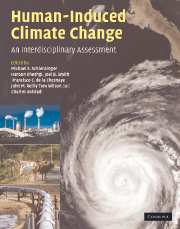Book contents
- Frontmatter
- Contents
- List of contributors
- Preface
- Part I Climate system science
- Part II Impacts and adaptation
- Part III Mitigation of greenhouse gases
- Part IV Policy design and decisionmaking under uncertainty
- 25 Climate policy design under uncertainty
- 26 Climate policy assessment using the Asia–Pacific Integrated Model
- 27 Price, quantity, and technology strategies for climate change policy
- 28 What is the economic value of information about climate thresholds?
- 29 Boiled frogs and path dependency in climate policy decisions
- 30 Article 2 and long-term climate stabilization: methods and models for decisionmaking under uncertainty
- 31 Whither integrated assessment? Reflections from the leading edge
- 32 Moving beyond concentrations: the challenge of limiting temperature change
- 33 International climate policy: approaches to policies and measures, and international coordination and cooperation
- Index
- Plate section
- References
25 - Climate policy design under uncertainty
from Part IV - Policy design and decisionmaking under uncertainty
Published online by Cambridge University Press: 06 December 2010
- Frontmatter
- Contents
- List of contributors
- Preface
- Part I Climate system science
- Part II Impacts and adaptation
- Part III Mitigation of greenhouse gases
- Part IV Policy design and decisionmaking under uncertainty
- 25 Climate policy design under uncertainty
- 26 Climate policy assessment using the Asia–Pacific Integrated Model
- 27 Price, quantity, and technology strategies for climate change policy
- 28 What is the economic value of information about climate thresholds?
- 29 Boiled frogs and path dependency in climate policy decisions
- 30 Article 2 and long-term climate stabilization: methods and models for decisionmaking under uncertainty
- 31 Whither integrated assessment? Reflections from the leading edge
- 32 Moving beyond concentrations: the challenge of limiting temperature change
- 33 International climate policy: approaches to policies and measures, and international coordination and cooperation
- Index
- Plate section
- References
Summary
Introduction
The uncertainty surrounding the costs and benefits associated with global climate change mitigation creates enormous obstacles for scientists, stakeholders, and especially policymakers seeking a practical policy solution. Scientists find it difficult to accurately quantify and communicate uncertainty; business stakeholders find it difficult to plan for the future; and policymakers are challenged to balance competing interests that frequently talk past each other.
Most emissions trading programs to date have focused on absolute caps that either remain fixed or decline over time. Examples include the US SO2 trading program and NOx Budget Program, the EU Emissions Trading Scheme (EU ETS), Southern California's NOx RECLAIM program, and a host of other regional pollutant trading schemes in the United States. Even the Kyoto Protocol, by most accounts, is viewed as a first step in capping emissions that must then lead to even lower levels in subsequent periods.
Yet the uncertainty surrounding climate change suggests that such an approach to regulating greenhouse gas emissions is problematic. On the one hand, we are unsure about what atmospheric concentrations need to be in the long run to prevent dangerous interference with the climate system. And regardless of the stabilization target, considerations of the global economic system and its dependence on fossil fuels suggests that optimal global emissions trajectories will continue to grow for some time (Wigley et al., 1996; Manne and Richels, 1999).
- Type
- Chapter
- Information
- Human-Induced Climate ChangeAn Interdisciplinary Assessment, pp. 305 - 313Publisher: Cambridge University PressPrint publication year: 2007



